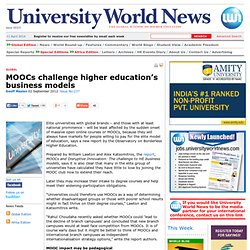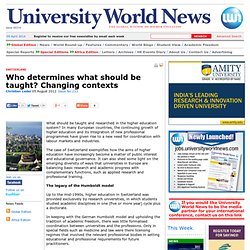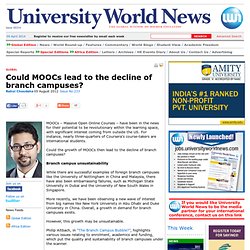

Directorate for Education. For additional documentation and data related to Education at a Glance 2012 Dynamic educational data award - Last September, we opened a competition challenge in collaboration with Visualizing.org, requiring graphic designers to construct a clear and compelling visualisation on the economic costs and returns on education.

The winners were Krisztina Szucs and Mate Cziner from Hungary. Their interactive chart condenses highly complex data on the costs and benefits of education around the world. It highlights important facts showing students, parents and policy makers where the real costs and benefits lie for them in relation to education. Massification continues to transform higher education. Higher education participation and enrolment has expanded considerably over the past century, and particularly since 1970.

However, growth predicted over the 30 years from 2000-30 is likely to be higher than that experienced between 1970 and 2000. The number of students enrolled in higher education by 2030 is forecast to rise from 99.4 million in 2000 to 414.2 million in 2030 – an increase of 314%. If an extra five years is added to these projections, the number of students pursuing higher education by 2035 is likely to exceed 520 million.
This growth is being fuelled by the transformation that we are witnessing in the developing and emerging regions and countries of the world – a growth that will only accelerate in the next decades. Will the rest of the world follow the US' devolutionary path? In the wake of the Cold War era, US research universities became increasingly characterised by a tribal mentality among schools and departments, and disciplines.

The surge in research funding, and in particular the tremendous growth rate among the major public universities, fostered the idea of the ‘multiversity’, which was less communal, and less aware of the institution's collective purpose. These devolutionary patterns have accelerated considerably over the past two decades in the US and reflect relatively new realities or influences: Within the public university sector, decreasing public subsidies have influenced a movement towards internal management decisions and organisations, which has eroded a previous model of revenue sharing (in tuition and fees, in overhead generated by extramural research, for example) and moved the emphasis to profit, loss and prestige centres.
MOOCs challenge higher education’s business models. Elite universities with global brands – and those with at least national prominence – will be least affected by the sudden onset of massive open online courses or MOOCs, because they will always have markets for people willing to pay for the elite model of education, says a new report by the Observatory on Borderless Higher Education.

Prepared by William Lawton and Alex Katsomitros, the report, MOOCs and Disruptive Innovation: The challenge to HE business models, says it is also clear that many in the elite group of universities have calculated they have little to lose by joining the MOOC club now to extend their reach. Later they may increase their intake to degree courses and help meet their widening-participation obligations.
“Universities could therefore use MOOCs as a way of determining whether disadvantaged groups or those with poorer school results might in fact thrive on their degree courses,” Lawton and Katsomitros write. MOOC impact may be pedagogical. BV maakt universiteiten rijk. London Metropolitan University to outsource most services to private firm. A London university has drawn up an ambitious outsourcing programme in which a swath of services, from managing its estates to marketing and finance, will be carried out by a private firm.

London Metropolitan University, which has more than 16,000 undergraduate students, has produced a tendering document under which all services except teaching and the vice-chancellor's office will be outsourced. The contract is valued at £74m over five years, according to the Exaro News website. The services include IT, library facilities and student services, such as counselling and careers advice. Three companies – Wipro, BT Global Services and Capita – are on the university's current shortlist.
On not being Superwoman, or, this is how she does it. The Boy, The Boys, and me.

It's been almost a year now since I returned from maternity leave to my full time job as an academic at UCL. At the time, I had three children aged 3 and under (The Boy, and The Boys - fraternal twins). Not a week has gone by without someone commenting on the fact that I am Superwoman. For Golden State's Public Colleges, No Silver Bullet - Government. Who determines what should be taught? Changing contexts. What should be taught and researched in the higher education system?

In many European countries, the continuing growth of higher education and its integration of new professional programmes have given rise to a new need for coordination with labour markets and industries. The case of Switzerland exemplifies how the aims of higher education have increasingly become a matter of public interest and educational governance. It can also shed some light on the emerging diversity of ways that universities in Europe are balancing basic research and academic progress with complementary functions, such as applied research and professional training.
The legacy of the Humboldt model Up to the mid-1990s, higher education in Switzerland was provided exclusively by research universities, in which students studied academic disciplines in one (five or more year) cycle plus a doctorate. The rise of the multinational university. More than 200 degree-granting international branch campuses of universities are now located in foreign countries.

But a new report says some universities are considering transforming the branch campus model into fully fledged multinational universities “by slicing up the global value chain in ways akin to multinational corporations”. Prepared by Sean Gallagher and Geoffrey Garrett from the United States Studies Centre at the University of Sydney Business School, the draft report says many of these universities are focusing on China because of its scale and rapid development, and on Singapore because of its aggressive government policy and high level of development.
By 2020, the report says, the world’s four largest countries in terms of population – China, India, Indonesia and the US – will account for more than half the global population of university-aged young people. Branch campuses Australia on the decline, US on the up. Could MOOCs lead to the decline of branch campuses? MOOCs – Massive Open Online Courses – have been in the news for their potential to be revolutionary within the learning space, with significant interest coming from outside the US.

For instance, nearly three-quarters of Coursera’s course-takers are international students. Could the growth of MOOCs then lead to the decline of branch campuses? 6 Ways in Which Digital is Changing the Face of Higher Education. Professors without borders. Will online learning spell the end of universities?

Stanford University: students from Bakersfield to Bangalore can now take its computer science courses online Primm, Nevada, is a three-casino, one-rollercoaster town in the Mojave Desert, just across the California state line and 40 minutes south of Las Vegas’s shimmering neon. Road-weary truckers can choose between Whiskey Pete’s, Terrible’s Lotto, and Starbucks. Making the case for internal communications in higher education. Louise Simpson, director, The Knowledge Partnership, a marketing and communications consultancy Statistics on the value of internal communications: Universities don't tend to regularly monitor their internal communications, but there are statistics out there from the private sector: • A survey by Watson Wyatt showed that firms that communicate effectively are four times more likely to report high levels of employee engagement compared with firms that communicate less effectively. • In 2008 a study of 90,000 employees by Towers Perrin found that companies with the highest levels of employee engagement achieve better financial results and are more successful in retaining their most valued employees than companies with lower levels of engagement. • In a 2008 survey of managers across the global, by Proudfoot Consulting, internal communication problems was the second most cited barrier to productivity.
Universities pledge to do more to secure gender equality. Top universities have committed to leading a drive to secure greater equality for female academics and researchers across Europe. A report from the League of European Research Universities, Women, Research and Universities: Excellence without gender bias, sets out actions that it says will overcome discrimination against women that prevents them from playing a full part in Europe’s research effort. The rise of for-profit universities and colleges. In the midst of the Great Recession, for-profit colleges and universities in the United States grew at a staggering pace in enrolment, profits and the corporate value of those traded on the New York Stock Exchange.
The 11 largest for-profit higher education companies, for instance, experienced an increase in enrolments of over 30% between 2008 and 2010. The downturn in the economy triggered ‘hypergrowth’ in for-profit institutions, including a rush of laid-off workers seeking job retraining. Before the recent bubble, steady growth in American for-profits was already a well-worn pattern. From 2000-10, the sector grew by some 235% in enrolment, increasing its market share from 3% to 9.1% of all tertiary enrolled students. MOOC's Aren't a Panacea, but That Doesn't Blunt Their Promise - Next. The battle for the future of higher ed has landed—at least for the time being—on a concept few in academe had even heard of a year ago: the Massive Open Online Course, or MOOC. The idea of offering free courses online to tens of thousands of students has suddenly become the latest, greatest way to “fix” higher ed, promoted by education-technology entrepreneurs and bemoaned by traditional academics.
Some of the country’s richest and most elite universities, including Harvard, Princeton, and Stanford, have been at the forefront of experiments with the format, and their moves have led some in higher ed to wonder if they’re missing out on something big if they don’t join in. That seemed to be the thinking of some members of the governing board at the University of Virginia last month, when they ousted the president, Teresa A. Sullivan, for not moving fast enough to position the university for the future (only to reinstate her two weeks later). Freelance, part-time or fixed-term: Is this the future of academic careers? On 2 July 2012, the University of Birmingham found itself at the heart of a twitterstorm. The academic community took to the social network and every other medium available to decry what was perceived as the final nail in the academic career coffin: a University of Birmingham job advert for a "voluntary postdoctoral position".
Academics protested, the University and College Union objected, and swiftly the university relented, taking down the ad and issuing a statement to explain its actions. Damage control done, but the debate about casualised employment for academics had begun - and rightly so. It seems one of the casualties of higher education reform, and the austere times that pre-empted it, has been working conditions for academics. It's a situation feared in the UK – one which is becoming a reality as Charlotte Blease, an early-career researcher tells us, but in the US, the tenure system is said to have "all but collapsed. " Greater access, more equal higher education are key to competitiveness.
PhDs What model works for developing countries? Doctoral research is often dubbed the ‘primary function of universities’. It supplies important academic training with the main focus on creating a highly skilled and knowledgeable labour force with great competence in influencing the ideas of wider society. The challenges of building a world-class university. Rio+20 coordinator hails role of HE in sustainable development. In an exclusive interview the executive coordinator of the Rio+20 conference on global sustainability, Elizabeth Thompson, told University World News why higher education is key to the international strategy she hopes will flow from agreements made at the event. “Education is transformative. We must build learning societies around the concept of sustainable development and get people to transition from the brown economy to the green economy.
And to change their practices and attitudes – that can only happen through education, both formal and informal.” Power and responsibility – The growing influence of global rankings. A few years ago I remember a dean at a Malaysian university urging faculty to look out for potential external examiners. More than half of tertiary teaching done by casuals. A shift in student mobility from China and India by 2015? Universities fear power of robot trading to lure maths talent. Research elite warns against obsessive bean-counting culture. Sustainable development becoming a higher education buzzword.
The changing role of leadership in international education. What Effect Is the Economic Crisis Really Having on Higher Education? - WorldWise. National policies massively influence mobile student decisions. Rankings rivals slug it out over new universities. Weakening tenure is an attack on academic freedom. Student Debt at Colleges and Universities Across the Nation - Interactive Graphic. The Research Works Act and the breakdown of mutual incomprehension. The Business Side of World University Rankings. Excellence schemes help top universities get better. Change Magazine - March/April 2010.